A Plasmonic Infrared Multiple-Channel Filter Based on Gold Composite Nanocavities Metasurface
Abstract
:1. Introduction
2. Materials and Methods
3. Results and Discussion
3.1. Simulated Results
3.2. Experimental Results
4. Conclusions
Author Contributions
Funding
Data Availability Statement
Acknowledgments
Conflicts of Interest
References
- Afzal, M.U.; Matekovits, L.; Esselle, K.P.; Lalbakhsh, A. Beam-Scanning Antenna Based on Near-Electric Field Phase Transformation and Refraction of Electromagnetic Wave Through Dielectric Structures. IEEE Access 2020, 8, 199242–199253. [Google Scholar] [CrossRef]
- Das, P.; Kaushik, M.; Ali, L. Single-layer polarization-insensitive frequency selective surface for beam reconfigurability of monopole antennas. J. Electromagn. Waves Appl. 2020, 34, 86–102. [Google Scholar] [CrossRef]
- Lalbakhsh, A.; Afzal, M.U.; Hayat, T.; Esselle, K.P.; Mandal, K. All-metal wideband metasurface for near-field transformation of medium-to-high gain electromagnetic sources. Sci. Rep. 2021, 11, 1–9. [Google Scholar] [CrossRef]
- Wang, Y.; Chong, H.B.; Zhang, Z.; Zhao, Y. Large-area fabrication of complex nanohole arrays with highly tunable plasmonic properties. ACS Appl. Mater. Interfaces 2020, 12, 37435–37443. [Google Scholar] [CrossRef] [PubMed]
- Suzuki, T.; Sekiya, M.; Sato, T.; Takebayashi, Y. Negative refractive index metamaterial with high transmission, low reflection, and low loss in the terahertz waveband. Opt. Express 2018, 26, 8314–8324. [Google Scholar] [CrossRef]
- Wang, F.; Martinson, A.B.; Harutyunyan, H. Efficient nonlinear metasurface based on nonplanar plasmonic nanocavities. ACS Photonics 2017, 4, 1188–1894. [Google Scholar] [CrossRef]
- Liu, L.; Wu, L.; Zhang, J.; Li, Z.; Zhang, B.; Luo, Y. Backward phase matching for second harmonic generation in negative-index conformal surface plasmonic metamaterials. Adv. Sci. 2018, 5, 1800661. [Google Scholar] [CrossRef] [PubMed]
- Liang, Y.; Lu, M.; Chu, S.; Li, L.; Peng, W. Tunable plasmonic resonances in the hexagonal nanoarrays of annular aperture for biosensing. Plasmonics 2016, 11, 205–212. [Google Scholar] [CrossRef]
- Zhu, J.; Lin, G.; Huang, Y.; Zhang, K.; Wu, M.; Wu, W.; Lu, P. Three-dimensional cavity-coupled metamaterials for plasmonic color and real-time colorimetric biosensors. Nanoscale 2020, 12, 4418–4425. [Google Scholar] [CrossRef] [PubMed]
- Kazanskiy, N.L.; Butt, M.A.; Khoniana, S.N. Carbon dioxide gas sensor based on polyhexamethylene biguanide polymer deposited on silicon nano-cylinders metasurface. Sensors 2021, 21, 378. [Google Scholar] [CrossRef] [PubMed]
- Lin, Y.S.; Dai, J.; Zeng, Z.; Yang, B.R. Metasurface color filters using aluminum and lithium niobate configurations. Nanoscale Res. Lett. 2020, 15, 1–8. [Google Scholar] [CrossRef]
- Sabra, W.; Azzam, S.I.; Song, M.; Povolotskyi, M.; Aly, A.H.; Kildishev, A.V. Plasmonic metasurfaces for subtractive color filtering: Optimized nonlinear regression models. Opt. Letters 2018, 43, 4815–4818. [Google Scholar] [CrossRef] [PubMed]
- Han, X.; Fan, Z.; Liu, Z.; Li, C.; Guo, L.J. Inverse design of metasurface optical filters using deep neural network with high degrees of freedom. InfoMat 2021, 3, 432–442. [Google Scholar] [CrossRef]
- Si, G.; Zhao, Y.; Liu, H.; Teo, S.; Zhang, M.; Jun Huang, T.; Danner, A.J.; Teng, J. Annular aperture array based color filter. Appl. Phys. Lett. 2011, 99, 033105. [Google Scholar] [CrossRef]
- Huang, T.J.; Yin, L.Z.; Shuang, Y.; Liu, J.Y.; Tan, Y.; Liu, P.K. Far-field subwavelength resolution imaging by spatial spectrum sampling. Phys. Rev. Appl. 2019, 12, 034046. [Google Scholar] [CrossRef] [Green Version]
- Luo, M.; Zhou, Y.; Wu, S.; Chen, L. Wide-angle broadband absorber based on one-dimensional metasurface in the visible region. Appl. Phys. Express 2017, 10, 092601. [Google Scholar] [CrossRef]
- Yannopapas, V. Periodic Arrays of Film-Coupled Cubic Nanoantennas as Tunable Plasmonic Metasurfaces. Photonics 2015, 2, 270–278. [Google Scholar] [CrossRef]
- Koshelev, K.; Lepeshov, S.; Liu, M.; Bogdanov, A.; Kivshar, Y. Asymmetric metasurfaces with high-Q resonances governed by bound states in the continuum. Phys. Rev. Lett. 2018, 121, 193903. [Google Scholar] [CrossRef] [Green Version]
- Dhama, R.; Caligiuri, V.; Petti, L.; Rashed, A.R.; Rippa, M.; Lento, R.; Termine, R.; Caglayan, H.; De Luca, A. Extraordinary effects in quasi-periodic gold nanocavities: Enhanced transmission and polarization control of cavity modes. ACS Nano 2018, 12, 504–512. [Google Scholar] [CrossRef]
- Ma, W.; Yu, S.; Zhao, T. Numerical study of an ultra-broadband perfect absorber from ultraviolet to near-infrared based on metal quadruple staircase structure. Opt. Commun. 2021, 493, 127037. [Google Scholar]
- Sun, Z.; Zhao, J.; Zhu, B.; Jiang, T.; Feng, Y. Selective wave-transmitting electromagnetic absorber through composite metasurface. AIP Adv. 2017, 7, 115017. [Google Scholar] [CrossRef] [Green Version]
- Gao, B.; Wang, Y.; Zhang, T.; Xu, Y.; He, A.; Dai, L.; Zhang, J. Nanoscale refractive index sensors with high figures of merit via optical slot antennas. ACS Nano 2019, 13, 9131–9138. [Google Scholar] [CrossRef] [PubMed]
- Jiang, L.; Li, Y.; Wang, H.; Zhu, Z.; Yuan, Q.; Wang, J.; Qu, S. Composite metasurface merging frequency selective surface and coding sequences for electromagnetic transmission–diffusion. J. Phys. D Appl. Phys. 2021, 54, 235304. [Google Scholar] [CrossRef]
- Sun, D.; Qi, L.; Liu, Z. Terahertz broadband filter and electromagnetically induced transparency structure with complementary metasurface. Results Phys. 2020, 16, 102887. [Google Scholar] [CrossRef]
- Tung, B.S.; Khuyen, B.X.; Kim, Y.J.; Lam, V.D.; Kim, K.W.; Lee, Y. Polarization-independent, wide-incident-angle and dual-band perfect absorption, based on near-field coupling in a symmetric metamaterial. Sci. Rep. 2017, 7, 1–7. [Google Scholar] [CrossRef] [Green Version]
- Shah, Y.D.; Grant, J.; Hao, D.; Kenney, M.; Pusino, V.; Cumming, D.R. Ultra-narrow line width polarization-insensitive filter using a symmetry-breaking selective plasmonic metasurface. ACS Photonics 2018, 5, 663–669. [Google Scholar] [CrossRef] [Green Version]
- Zhang, J.; Dai, J.; Yang, J.; Hu, C.; Gao, B.; Xu, Y.; Zhang, J. Invertible plasmonic spin-Hall effect at nanoscale based on U-shaped optical slot nanoantenna. Nanotechnology 2019, 30, 345201. [Google Scholar] [CrossRef]
- Hong, J.; Son, H.; Kim, C.; Mun, S.E.; Sung, J.; Lee, B. Absorptive metasurface color filters based on hyperbolic metamaterials for a CMOS image sensor. Optics Express 2021, 29, 3643–3658. [Google Scholar] [CrossRef]
- Lalbakhsh, A.; Esselle, K.P. Directivity improvement of a Fabry-Perot cavity antenna by enhancing near field characteristic. In Proceedings of the 17th International Symposium on Antenna Technology and Applied Electromagnetics (ANTEM), Montreal, QC, Canada, 10–13 July 2016. [Google Scholar]
- To, N.; Juodkazis, S.; Nishijima, Y. Detailed Experiment-Theory Comparison of Mid-Infrared Metasurface Perfect Absorbers. Micromachines 2020, 11, 409. [Google Scholar] [CrossRef] [Green Version]
- Seniutinas, G.; Balčytis, A.; Reklaitis, I.; Chen, F.; Davis, J.; David, C.; Juodkazis, S. Tipping solutions: Emerging 3D nano-fabrication/-imaging technologies. Nanophotonics 2017, 6, 923–941. [Google Scholar] [CrossRef]
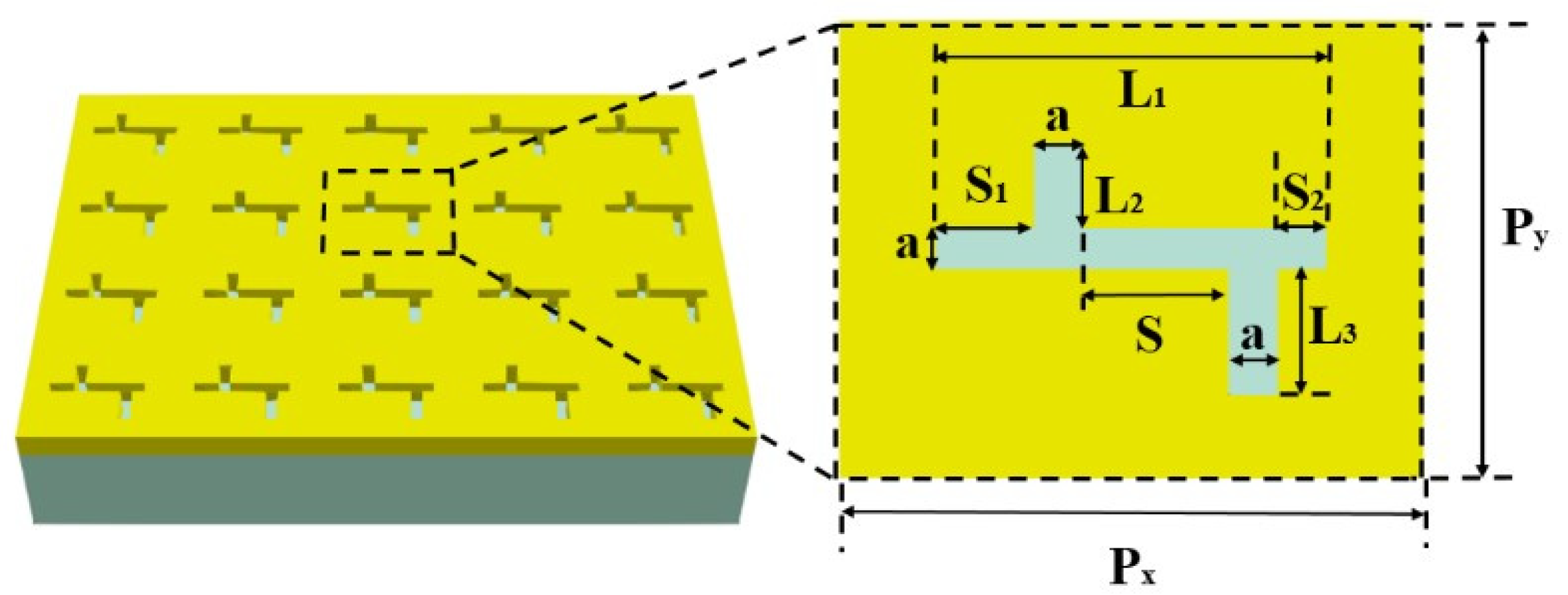

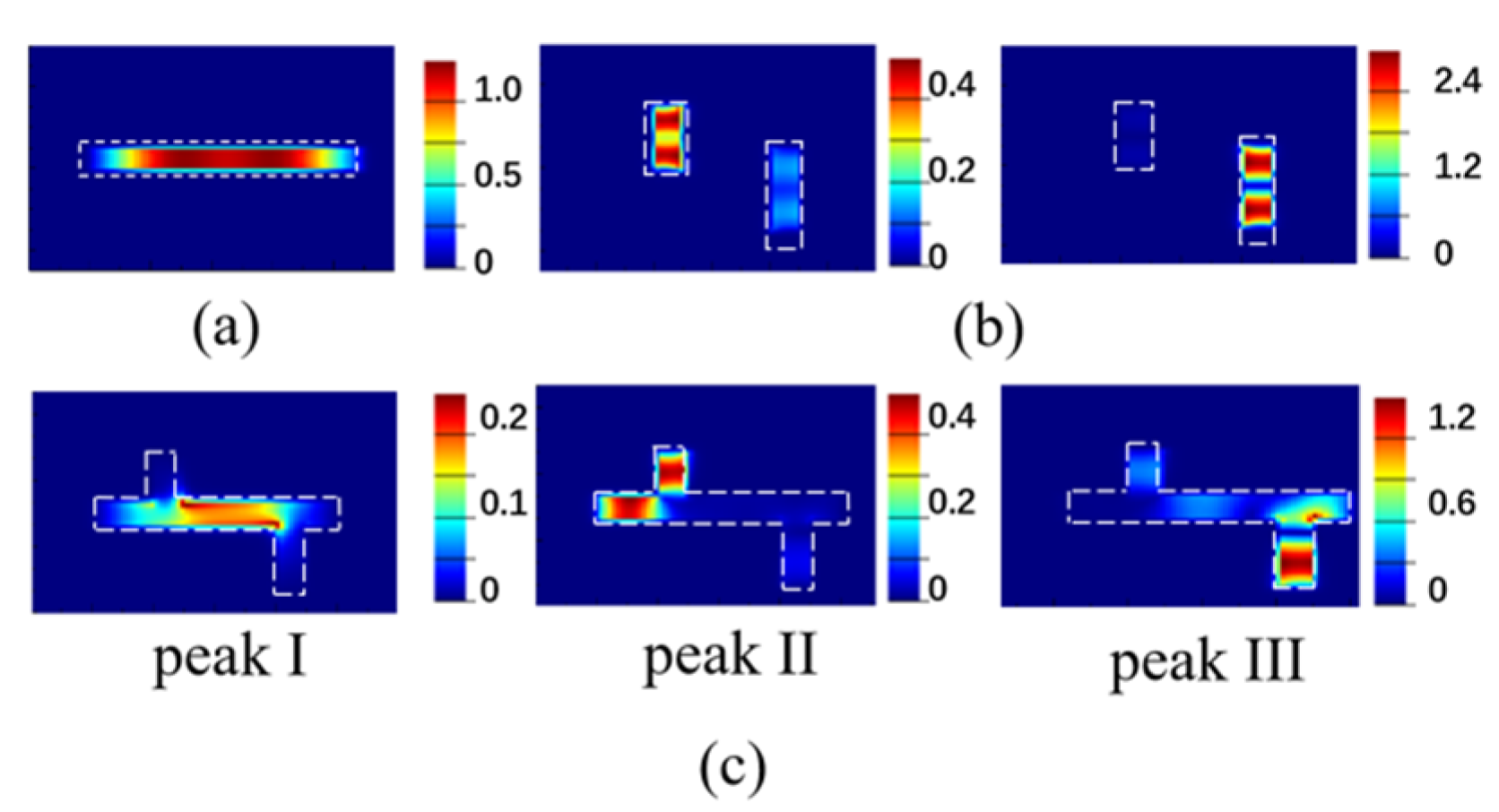
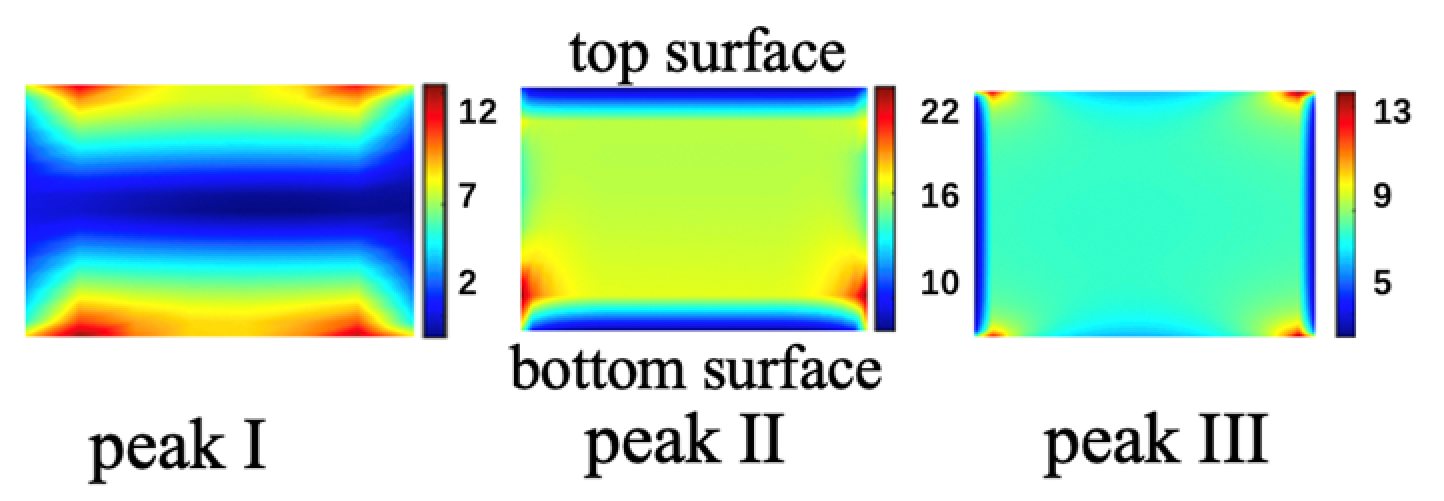

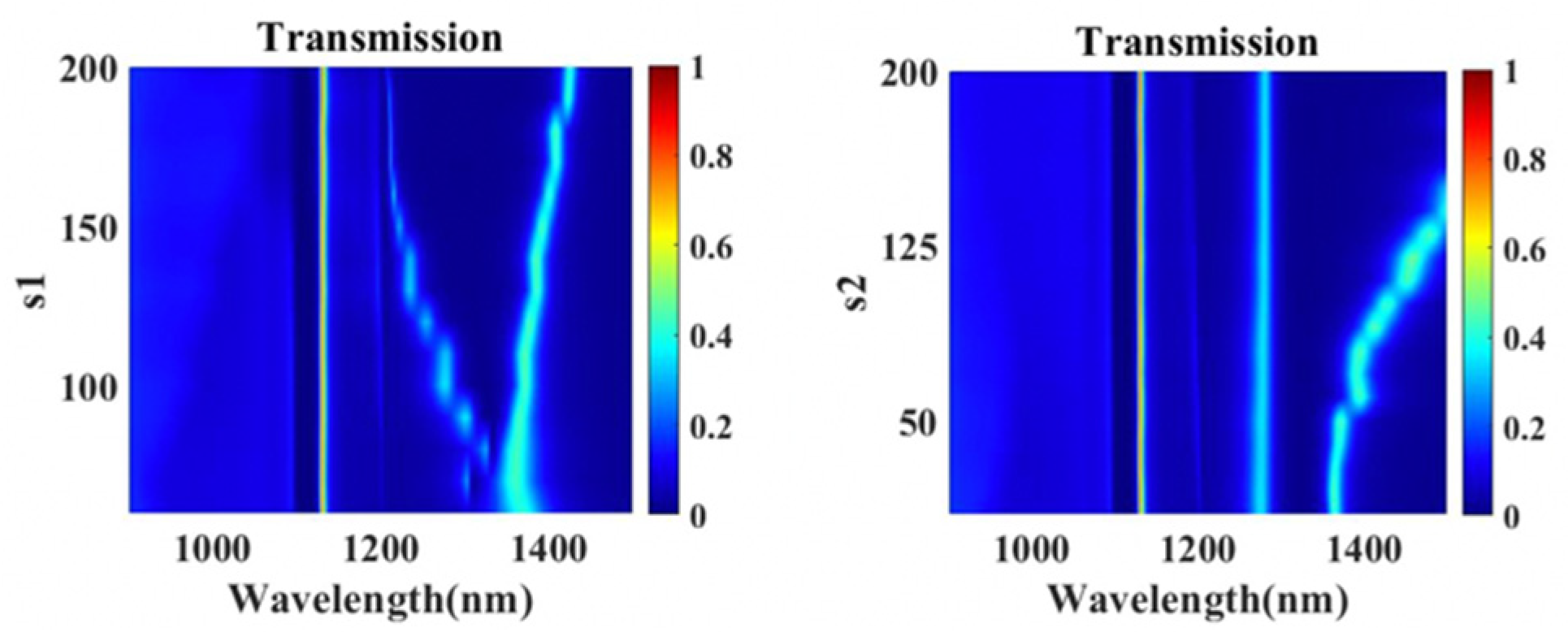
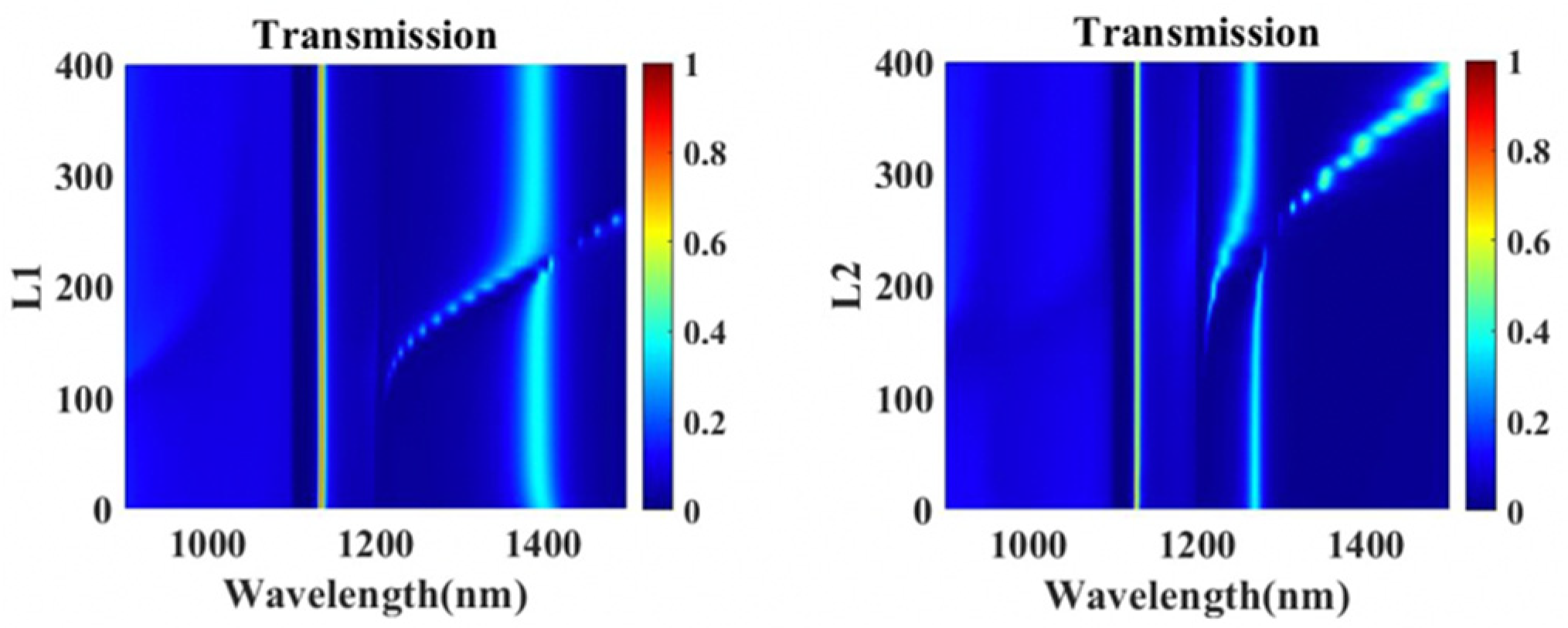
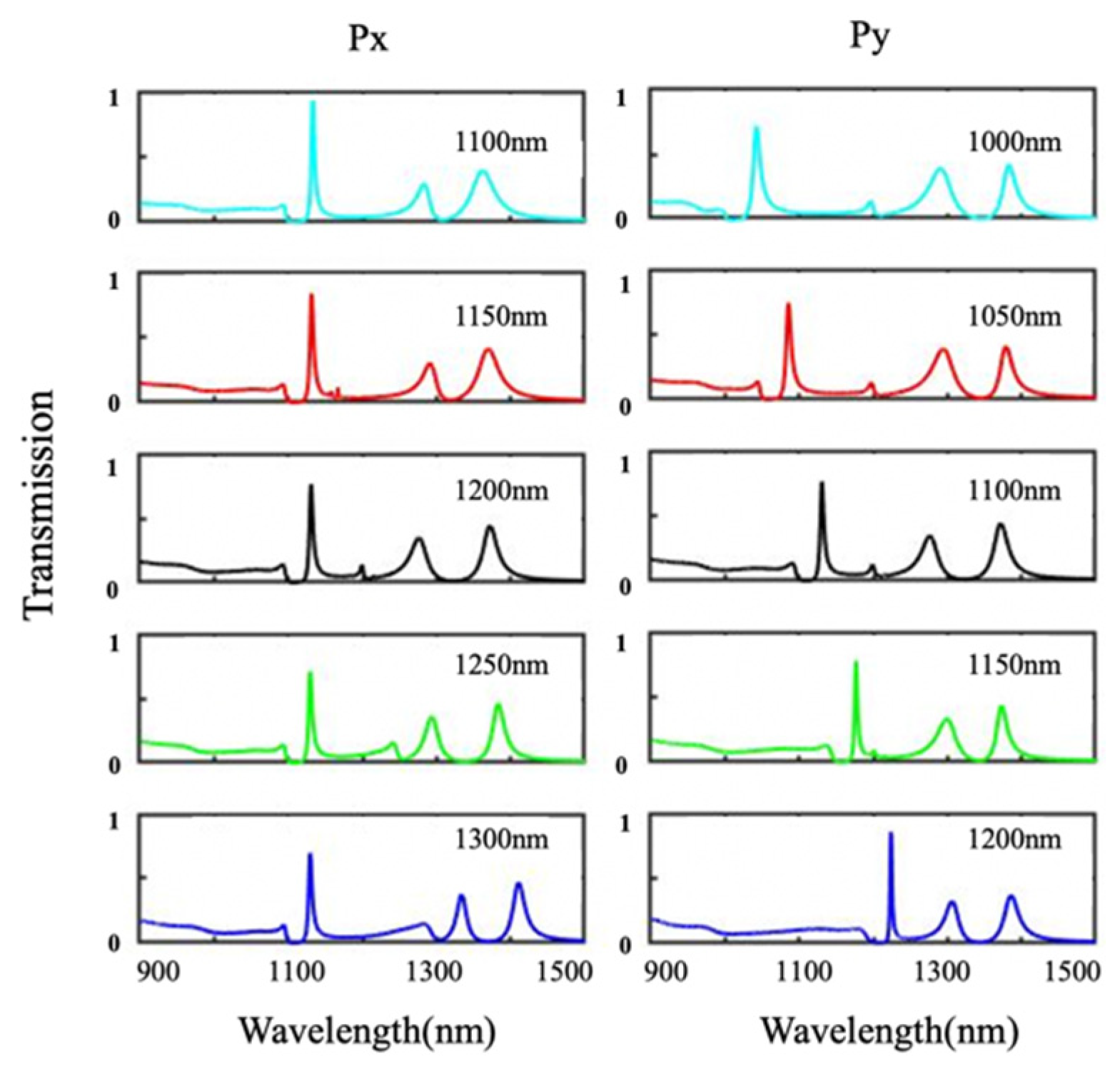
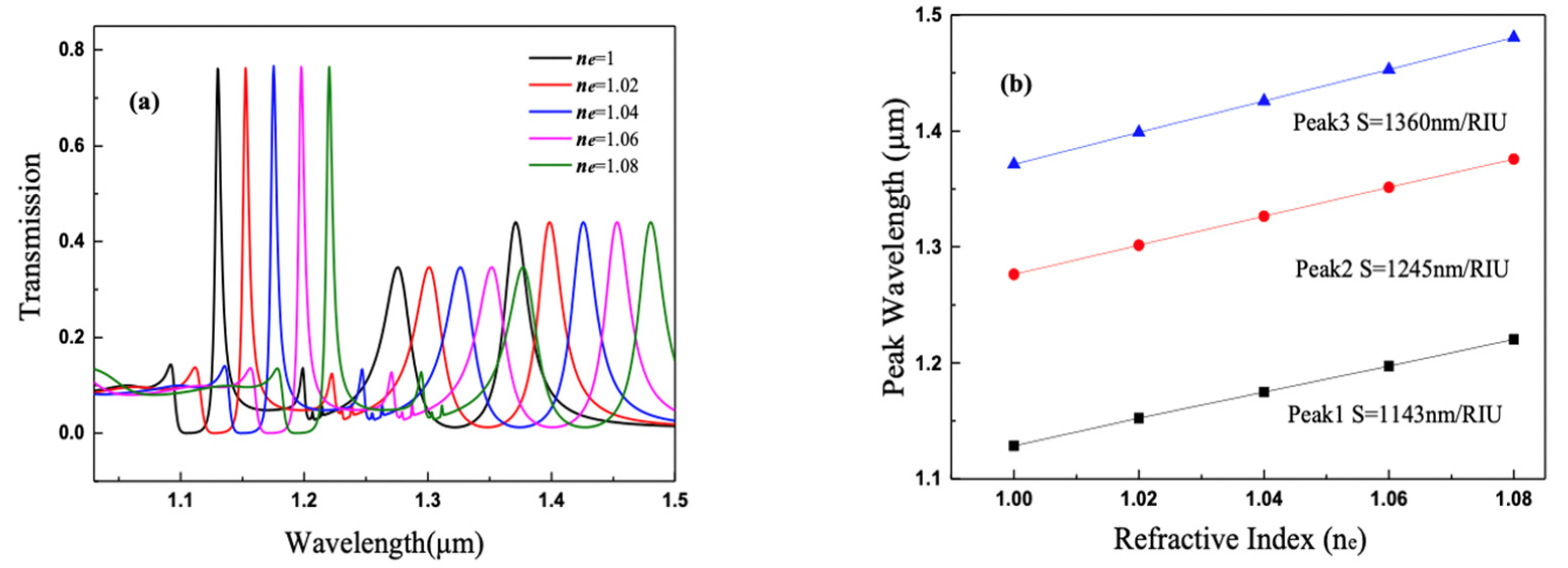


Publisher’s Note: MDPI stays neutral with regard to jurisdictional claims in published maps and institutional affiliations. |
© 2021 by the authors. Licensee MDPI, Basel, Switzerland. This article is an open access article distributed under the terms and conditions of the Creative Commons Attribution (CC BY) license (https://creativecommons.org/licenses/by/4.0/).
Share and Cite
Zhang, J.; Yu, X.; Dong, J.; Yang, W.; Liu, S.; Shen, C.; Duan, J.; Deng, X. A Plasmonic Infrared Multiple-Channel Filter Based on Gold Composite Nanocavities Metasurface. Nanomaterials 2021, 11, 1824. https://doi.org/10.3390/nano11071824
Zhang J, Yu X, Dong J, Yang W, Liu S, Shen C, Duan J, Deng X. A Plasmonic Infrared Multiple-Channel Filter Based on Gold Composite Nanocavities Metasurface. Nanomaterials. 2021; 11(7):1824. https://doi.org/10.3390/nano11071824
Chicago/Turabian StyleZhang, Jialin, Xuanyi Yu, Jingxin Dong, Weiji Yang, Shuang Liu, Chongyang Shen, Jiacheng Duan, and Xiaoxu Deng. 2021. "A Plasmonic Infrared Multiple-Channel Filter Based on Gold Composite Nanocavities Metasurface" Nanomaterials 11, no. 7: 1824. https://doi.org/10.3390/nano11071824
APA StyleZhang, J., Yu, X., Dong, J., Yang, W., Liu, S., Shen, C., Duan, J., & Deng, X. (2021). A Plasmonic Infrared Multiple-Channel Filter Based on Gold Composite Nanocavities Metasurface. Nanomaterials, 11(7), 1824. https://doi.org/10.3390/nano11071824





